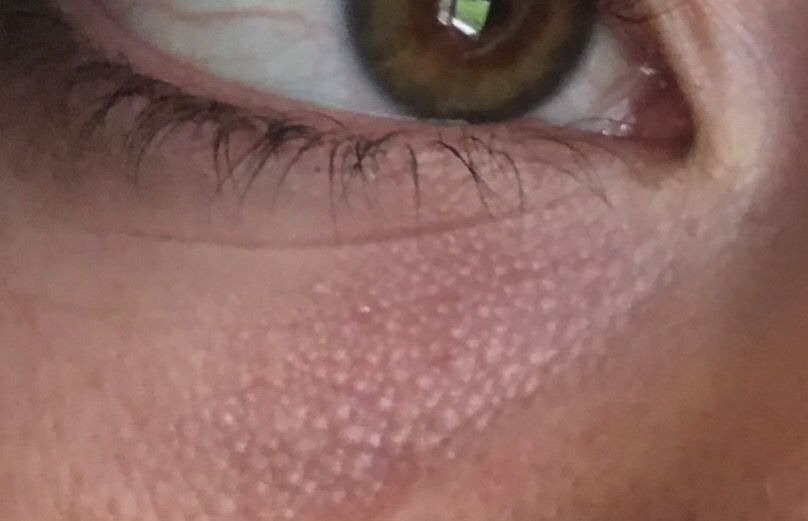When it comes to achieving clear and flawless skin, the presence of stubborn bumps can be frustrating. One such common skin condition is milia, tiny white or yellowish bumps that appear on the surface of the skin. In this blog post, we will delve into what milia bumps are, their causes, and explore effective methods to get rid of them, helping you regain your smooth complexion.

What are Milia Bumps?
Milia, also known as milk spots or oil seeds, are small cysts that form when dead skin cells become trapped beneath the surface of the skin. They typically manifest as tiny white or yellowish bumps with a smooth texture. Milia bumps are most commonly found on the face, particularly around the eyes, nose, cheeks, and forehead. While they can occur in people of all ages, they are more prevalent in newborns and infants.
Causes of Milia Bumps
- Retention of Dead Skin Cells: Milia bumps occur when dead skin cells are unable to shed properly and become trapped beneath the skin’s surface, forming tiny cysts.
- Hormonal Factors: Hormonal changes during puberty, pregnancy, or menopause can contribute to the development of milia bumps.
- Skin Damage: Skin trauma or injury, such as burns, blisters, or dermabrasion, can trigger the formation of milia as part of the healing process.
- Use of Heavy Skincare Products: The use of thick or oily skincare products can clog the pores and lead to the accumulation of dead skin cells, contributing to milia formation.
Different Types of Milia
- Primary Milia: These are most commonly found in infants and occur naturally without any underlying skin conditions. They often disappear on their own within a few weeks or months.
- Secondary Milia: Secondary milia develop due to underlying skin conditions or trauma. They may persist for a longer period and require targeted treatment to remove them effectively.
Treating Milia Bumps:
- Gentle Exfoliation: Regular exfoliation helps to remove dead skin cells and prevent their buildup. Opt for a gentle exfoliator or chemical exfoliants like AHAs (alpha hydroxy acids) or BHAs (beta hydroxy acids) to promote skin cell turnover.
- Avoid Picking or Squeezing: Milia bumps should not be squeezed or popped, as this can lead to inflammation, infection, or scarring. Letting them resolve naturally or seeking professional assistance is advisable.
- Retinoids: Topical creams containing retinoids can aid in the removal of milia by accelerating cell turnover and exfoliation. However, consult with a dermatologist before using retinoids, as they may cause skin irritation.
- Professional Extraction: Dermatologists or licensed skincare professionals can perform extraction techniques, such as lancing or de-roofing, to safely remove milia bumps. This procedure should only be done by a trained professional to minimize the risk of scarring or infection.
- Cryotherapy: In certain cases, cryotherapy, which involves freezing the milia bumps with liquid nitrogen, may be used to remove stubborn milia.
- Microdermabrasion: This minimally invasive procedure utilizes a specialized device to gently exfoliate the skin’s surface, helping to eliminate milia bumps.
- Chemical Peels: Mild chemical peels containing alpha hydroxy acids (AHAs) can aid in the removal of milia by promoting exfoliation. However, it’s important to consult with a professional to determine the appropriate strength and duration of the peel.
Prevention and Skincare Tips
- Cleanse Regularly: Maintaining a consistent skincare routine is essential for preventing the formation of milia bumps. Cleanse your face twice a day using a gentle, non-comedogenic cleanser to remove dirt, oil, and impurities without stripping the skin.
- Use Lightweight, Non-Comedogenic Products: Opt for lightweight moisturizers, serums, and makeup products that are labeled as non-comedogenic. These products are less likely to clog your pores, reducing the risk of milia formation.
- Protect Your Skin from Sun Damage: Excessive sun exposure can lead to skin damage and hinder the natural exfoliation process. Protect your skin by wearing sunscreen with a high SPF daily, and seek shade during peak hours.
- Avoid Heavy Oils and Emollients: Thick oils or heavy emollients have a higher chance of clogging pores and trapping dead skin cells. Consider using lightweight, oil-free alternatives to moisturize your skin.
- Hydrate and Maintain a Balanced Diet: Drinking an adequate amount of water helps keep your skin hydrated and promotes overall skin health. Additionally, maintaining a balanced diet rich in fruits, vegetables, and antioxidants can support healthy skin.
- Gentle Makeup Removal: Be diligent in removing your makeup before going to bed. Use a gentle makeup remover and cleanse your face thoroughly to prevent the buildup of makeup residue.
- Avoid Harsh Scrubs and Abrasive Techniques: Steer clear of harsh scrubs or aggressive techniques that can damage the skin’s protective barrier. Instead, choose mild exfoliants and be gentle when applying them to your face.
Milia bumps can be a frustrating skin concern, but with the right knowledge and skincare practices, they can be effectively managed and treated. Remember, patience is key, as milia bumps may take time to disappear. If you’re unsure or concerned about your milia, it’s always best to consult with a dermatologist or skincare professional who can provide personalized advice and treatment options. By following a consistent skincare routine and adopting preventive measures, you can work towards achieving a smooth, clear complexion free from milia bumps.
